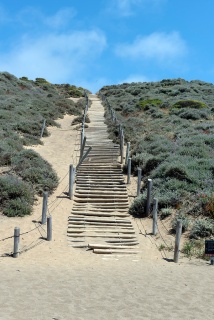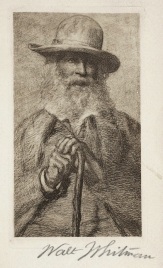Digital Footprints on the Sands of Time

Mesquite Flat Sand Dunes, Death Valley. Library of Congress, Prints and Photographs, photo by Carol M. Highsmith. LC-DIG-highsm-24050.
“Lives of great men all remind us / We can make our lives sublime. / And, departing, leave behind us / Footprints on the sands of time”
In these familiar lines from his 1838 poem “A Psalm of Life,” Henry Wadsworth Longfellow offered the famous image of “footprints on the sands of time.” Written during the years after the death of the poet’s first wife and before his marriage to his second, the poem is one of those that Longfellow liked to call his “psalms.” The footprints are also a great image for the sometimes fleeting, sometimes longer lasting, digital materials that emerge from major projects today.
Our Manifold Greatness project has certainly left behind hundreds, if not thousands, of ephemeral footprints on Twitter, Facebook, and local news site calendars; it also leaves some more enduring footpaths that seem likely to continue long after this project is complete. In addition to the project’s own core resources previously chronicled on this blog (the website, the app, the Folger videos, the traveling exhibit YouTube videos, the Folger exhibition pages, the exhibition opening podcast, and more), Manifold Greatness has inspired a far-flung array of other online materials. Here’s a trail guide to those we’ve spotted so far:

Baker Beach, San Francisco. Library of Congress, Prints and Photographs, photo by Carol M. Highsmith. LC-DIG-highsm-20593.
On iTunes U, look for the series of Manifold Greatness lectures at Oxford (as audio or video). At the University of Wyoming, a Manifold Greatness page in the Wyoming Scholars Repository brings together five illustrated lecture videos (also available on YouTube): “The Role the King James Bible Played in Mormonism and the Settlement of the West” (Philip Barlow), “The World’s First Scripture Translations: The Targums and the Septuagint” (Paul V.M. Fletcher), “Seventeenth Century Needleworks and the King James Bible” (Susan Frye), and “Jerome’s Vulgate Translation: The First People’s Bible” (Kris Utterback).
Several of the Manifold Greatness traveling exhibit host libraries—particularly those at colleges and universities—used Libguides to create what are, in effect, small, focused websites, ranging from lists of books and resources at that library, to online sources, to detailed surverys of the exhibit cases in their own accompanying exhibitions. So far, we know of seven Manifold Greatness Libguides, all quite different, and each leaving its own set of digital footprints to follow: Arizona State University Libraries, Harford Community College Library, Loyola Marymount University, Pepperdine University Libraries, University of Wyoming Libraries, Whitworth University Library, and (on the King James Bible Quadricentennial), William Carey University.
On Vimeo, Claremont Graduate University, one of the earliest Manifold Greatness exhibit sites, has posted “‘A Bible! A Bible! We Have Got a Bible!’: Mormonism’s Selective Affair with the King James Bible” (Patrick Mason) and “The Bible and Translation” (Tammi Schneider). And in the last two weeks, the Nancy Guinn Memorial Library in Conyers, Georgia, posted on Vimeo, too, sharing a recent presentation by Michael Morgan on “The Origins of the King James Bible,” that includes highlights of Morgan’s collection of Bibles and related materials, including Handel’s Messiah.
We invite you to follow some of these Manifold Greatness digital footprints, and see what new content and ideas you may find. But don’t be too surprised if you discover, over the years, that some of the links are broken and their footprints faded back into the sand. As Longfellow noted in 1838, such is the nature of life—digital and otherwise.
Manifold Greatness: The Creation and Afterlife of the King James Bible is on exhibit at the Nancy Guinn Memorial Library in Conyers, Georgia, through July 12.
Walt Whitman’s American Bible
Happy Birthday, Walter! Walt Whitman’s Leaves of Grass is deeply indebted to the King James Bible, despite Whitman’s claims to be utterly original. In fact, Whitman wrote of his work as “the Great Construction of a New Bible.” The first, slim, volume of Leaves of Grass was published in 1855. Whitman paid for it himself, and there were fewer than 800 copies. The rest of Whitman’s poetic life was spent revising and adding to this collection, culminating in the final “Deathbed” edition of 1891. The original 95 pages had swollen to almost 450, and the 12 poems of the 1855 edition had become nearly 400.
Various explanations have been offered for Whitman’s title, “Leaves of Grass,” including the obvious pun on the “leaves” of a book. But somewhere in the background is probably the statement of Isaiah that “All flesh is grass, and all the goodliness thereof is as the flower of the field: The grass withereth, the flower fadeth: because the spirit of the LORD bloweth upon it: surely the people is grass” (Isaiah 40:6-7). Isaiah’s grim prophecy of death is transformed by Whitman into a celebration of the natural cycle, in which death is part of life and the poet, like all the people he sings of in his poem, returns to the earth from which he came. As Whitman writes in “Song of Myself,” “I bequeath myself to the dirt to grow from the grass I love,/ If you want me again look for me under your boot-soles.”
“Song of Myself,” the first poem in the 1855 edition, may also derive its title from the Bible. The great Old Testament celebration of love is the Song of Songs or Song of Solomon, an erotic dialogue between a man and a woman rich in metaphors of spices, fruits, animals, and birds. Whatever the original author intended, Jews and Christians have both traditionally interpreted the poem as an allegory for the love between God and humanity. Whitman’s “Song,” typically and radically, is not of God, or even a lover, but of himself: “I celebrate myself, and sing myself.”
One striking feature of Whitman’s poetry is his rambling but rhetorically powerful prose-poetic line, often full of lists of people, places, and things. He adapts this line, just as William Blake did before him (and Alan Ginsberg after), from the parallelistic prose of Isaiah and other Old Testament prophets, in the King James Version. Leaves of Grass may be a new American Bible, but in some ways it sounds a lot like the old one.
Hannibal Hamlin, associate professor of English at The Ohio State University, was co-curator of the Manifold Greatness exhibition at the Folger Shakespeare Library.
Note: You can read (or hear) about the Whitman engraving shown here on the web page Personalizing Shakespeare, by Louis B. Thalheimer Head of Reference Georgianna Ziegler.










